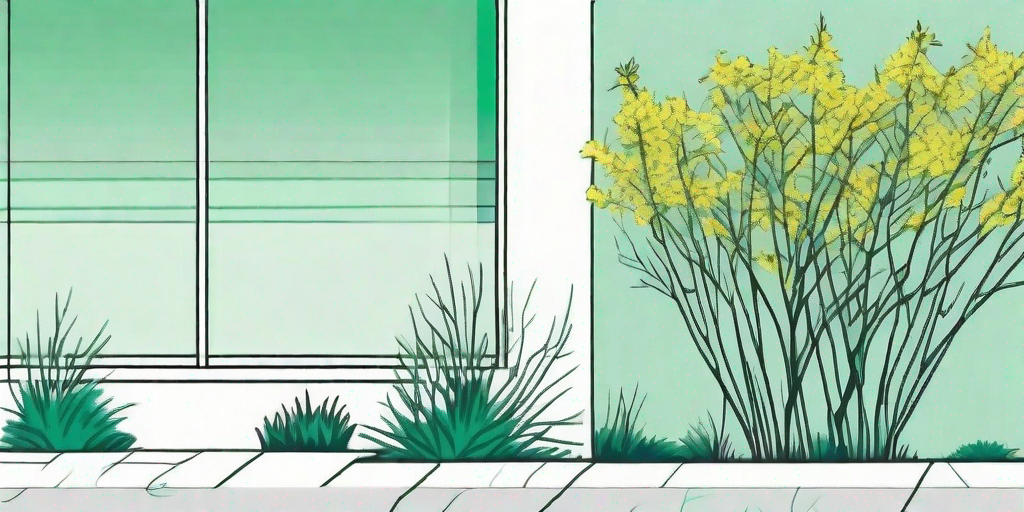
Welcome, green-thumbed enthusiasts and aspiring horticulturists! Today, we're diving into the vibrant world of Forsythia, that golden harbinger of spring. If you're looking to keep your Forsythia bush in tip-top shape, you've come to the right place. We're going to share some cheeky trimming tips that will have you pruning your Forsythia like a pro in no time. So, let's get our hands dirty, shall we?
The Forsythia: A Brief Introduction
Before we get into the nitty-gritty of pruning, let's take a moment to appreciate the Forsythia. This deciduous shrub, native to Asia, is a real showstopper in the spring garden. Its bright yellow flowers are among the first to bloom, signaling the end of winter and the beginning of warmer days. But the Forsythia isn't just a pretty face. It's also a hardy plant that can withstand a variety of conditions.
There are several species of Forsythia, but the most common one you'll find in gardens is Forsythia x intermedia. This hybrid species is a cross between F. suspensa and F. viridissima. It's known for its abundant flowers and vigorous growth, which can be both a blessing and a curse. Without proper pruning, your Forsythia can quickly become an unruly mess. But fear not, we're here to help you tame that golden beast.
Why Prune Your Forsythia?
Pruning is an essential part of plant care, and the Forsythia is no exception. Regular pruning helps maintain the plant's shape, promotes healthy growth, and encourages abundant flowering. Plus, it's a great way to keep your Forsythia from taking over your garden.
But when it comes to Forsythia, timing is everything. Prune too early, and you'll cut off the buds that produce those beautiful yellow flowers. Prune too late, and you'll stunt the plant's growth. So, when is the best time to prune your Forsythia? Read on to find out.
When to Prune Your Forsythia
The best time to prune your Forsythia is in early spring, just after it has finished blooming. This gives the plant plenty of time to produce new growth and set buds for the next year's flowers. If you prune your Forsythia in the fall or winter, you risk cutting off the buds and missing out on the spring bloom.
However, if your Forsythia is overgrown or out of shape, you can do a hard prune in late winter or early spring before the plant starts to bloom. This will sacrifice the current year's flowers, but it will give the plant a fresh start and promote vigorous growth.
How to Prune Your Forsythia
Now that we've covered the why and when, let's get to the how. Pruning your Forsythia is a straightforward process, but it does require some precision and a bit of elbow grease. Here's a step-by-step guide to help you prune your Forsythia like a pro.
Step 1: Gather Your Tools
Before you start pruning, you'll need a few tools. A pair of sharp pruning shears is essential for making clean cuts. For larger branches, you may need a pruning saw. And don't forget your gloves to protect your hands from thorns and sharp branches.
Step 2: Assess Your Forsythia
Before you start cutting, take a moment to assess your Forsythia. Look for dead or diseased branches, branches that are crossing or rubbing against each other, and any branches that are growing in the wrong direction. These are the branches you'll want to remove first.
Step 3: Make Your Cuts
When pruning, make your cuts at a 45-degree angle, about 1/4 inch above a bud that is facing the direction you want the branch to grow. This encourages the plant to grow in a desirable shape and direction.
Step 4: Thin Out the Plant
If your Forsythia is dense and crowded, you'll want to thin it out. Remove some of the older, thicker branches at the base to allow more light and air to reach the center of the plant. This promotes healthy growth and helps prevent disease.
Step 5: Shape Your Forsythia
Finally, shape your Forsythia by trimming the ends of the branches. Remember, Forsythia naturally grows in a fountain-like shape, so try to maintain this shape as you prune. Avoid cutting the plant into a box or ball shape, as this can inhibit flowering and make the plant look unnatural.
Frequently Asked Questions
Can I prune my Forsythia in the fall?
While it's possible to prune your Forsythia in the fall, it's not recommended. Pruning in the fall can stimulate new growth that may not have time to harden off before winter, making it susceptible to winter damage. Additionally, you risk cutting off the buds for next year's flowers.
What if I prune my Forsythia too hard?
Forsythia is a hardy plant and can usually withstand a hard prune. However, a hard prune will likely result in fewer flowers the following spring. If you've pruned your Forsythia too hard, don't worry. Just give it some time, and it should bounce back.
Can I propagate Forsythia from cuttings?
Yes, you can propagate Forsythia from cuttings. Simply take a cutting from a healthy branch, dip the cut end in rooting hormone, and plant it in a pot with well-draining soil. Keep the soil moist, and in a few weeks, you should see new growth.
Conclusion
Pruning your Forsythia may seem like a daunting task, but with these tips, you'll be a pro in no time. Remember, the key to successful pruning is timing, precision, and a bit of patience. So, grab your pruning shears, put on your gloves, and get ready to tame that golden beast. Happy pruning!















